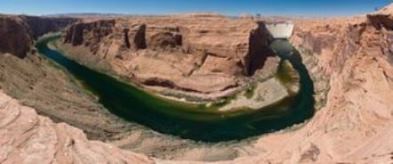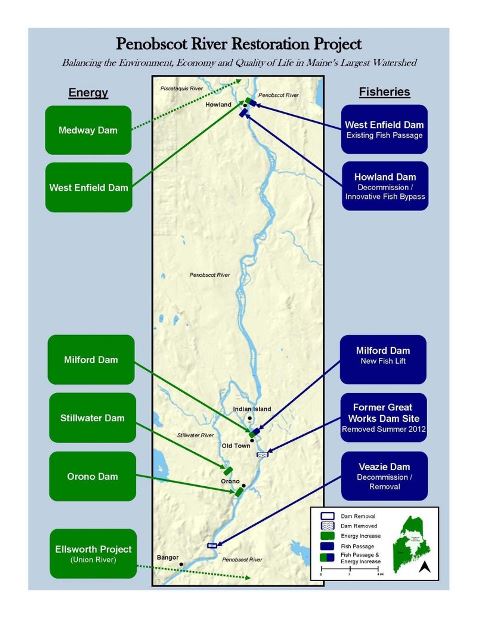
Reposted from Environmental Law Prof Blog.
A standard environmental history of American dams unfolds something like this: As a nation, we had a long love affair with dams. And while they helped our nation grow into an industrial power, the environmental side-effects were immense: lost forests and farmland, drowned canyons, and, perhaps most importantly, devastated fisheries. Yet even after some of those consequences became apparent, the story goes, dam-building marched on, powered by bureaucratic inertia and the seemingly unstoppable engine of pork-barrel politics. Finally, in the 1980s, we stopped, but by then we had built approximately one dam for every day of our national existence. As former Secretary of the Interior Bruce Babbitt once put it, “we overdosed.” We’re now starting to take dams out, and those dam removals often lead to dramatic environmental improvements. But, in the standard narrative, the removals aren’t coming nearly fast enough.
they helped our nation grow into an industrial power, the environmental side-effects were immense: lost forests and farmland, drowned canyons, and, perhaps most importantly, devastated fisheries. Yet even after some of those consequences became apparent, the story goes, dam-building marched on, powered by bureaucratic inertia and the seemingly unstoppable engine of pork-barrel politics. Finally, in the 1980s, we stopped, but by then we had built approximately one dam for every day of our national existence. As former Secretary of the Interior Bruce Babbitt once put it, “we overdosed.” We’re now starting to take dams out, and those dam removals often lead to dramatic environmental improvements. But, in the standard narrative, the removals aren’t coming nearly fast enough.
I agree with this story, and most of the underlying facts aren’t really in dispute. But another narrative of dams lingers on, particularly — but not exclusively — in the reports of the government agencies that manage much of our hydropower. In this story, hydropower remains an essential part of our energy mix. Hydropower still comprises approximately 7 percent of our national energy-generating capacity (globally, the percentage is higher). While that number may seem small, it dwarfs the contributions of wind, solar, geothermal, and other renewables. For a few key reasons, that 7 percent is also particularly useful. First, the greenhouse gas emissions of existing hydropower are minimal, at least in the United States. Second, both solar and wind power are somewhat intermittent in their availability, and studies finding that we can rely much more heavily on renewable energy (like this one here, which Lesley McAllister recently blogged about) generally assume that hydropower will even out some of the dips in the supply curve.
Hydropower’s share also could grow. Some recent studies have identified huge amounts of untapped hydropower capacity, much of it at  sites where we already have dams (the United States has approximately 80,000 non-hydropower dams). How much of that capacity is economically available, given a reasonable set of environmental constraints, is a hotly debated question. But at least some capacity for expansion exists, and renewable portfolio standards or—dare we hope—a price on carbon could make expanded hydro look much more economically appealing. In this alternative narrative, then, hydro occupies a crucial and potentially dynamic role in our energy future. And this narrative is not just idle storytelling. In multiple bills, including, most recently, the Water Resources Development Act recently passed by the Senate, Congress has signaled its continuing enthusiasm for hydropower.
sites where we already have dams (the United States has approximately 80,000 non-hydropower dams). How much of that capacity is economically available, given a reasonable set of environmental constraints, is a hotly debated question. But at least some capacity for expansion exists, and renewable portfolio standards or—dare we hope—a price on carbon could make expanded hydro look much more economically appealing. In this alternative narrative, then, hydro occupies a crucial and potentially dynamic role in our energy future. And this narrative is not just idle storytelling. In multiple bills, including, most recently, the Water Resources Development Act recently passed by the Senate, Congress has signaled its continuing enthusiasm for hydropower.
We often think that our energy needs inevitably will conflict with environmental protection, and these two narratives might on their face seem to reinforce that view. But is the tension between these narratives unavoidable? The answer, perhaps surprisingly, is "not always," and a case study illustrates the possibilities. On the Penobscot River in Maine, an ambitious dam removal project is currently underway. Once completed, the project (which I’ve blogged about here, and which is described in more detail here, here, and here) will involve multiple dam removals and fish passage improvements on the dams that remain. Hundreds of miles of river habitat will be opened to the river’s many anadromous species — fish that breed in freshwater, but spend most of their lives in saltwater — and scientists anticipate exponential increases in their populations, with benefits for both freshwater and saltwater ecosystems. All of this will happen without any loss of hydropower. By moving and upgrading facilities, Black Bear Hydro LLC, which owns the dams, will be able to sustain its present generating capacity. Both the upgrades and the environmental improvements arose out of one big negotiated deal, with environmental groups and the Penobscot Indian Nation essentially offering support for what otherwise would have been contentious license renewals (as well as a substantial financial payment, which some of the groups helped raise) in return for the environmental improvements. In short, on the Penobscot, environmental improvements and hydropower efficiency upgrades were closely, and legally, linked.
Could that be repeated? Physically, it seems possible. Most river basins in the United States contain multiple dams, and trading removals or improved fish passage in some locations for energy upgrades in others seems like a sensible step. But the legal challenges are substantial. On most rivers, many different entities own the dams, creating a significant coordination challenge, and public governance of watersheds is famously fragmented. As anyone who has worked with FERC licensing knows, renewing even a single license is a long and difficult process, and linking multiple licensing processes together sounds like a formidable task. Consequently, the legal challenges are daunting.
But are they insurmountable? I don’t yet know. But over the next few months, I’ll be taking a close and careful look at hydropower law to try to figure these questions out. The research project goal, ultimately, is to identify legal reforms that will allow our hydropower system to sustain or increase its benefits while reducing, hopefully substantially, the environmental burdens it imposes.

The Great Works Dam site, before (left) and after.
Glen Canyon Dam image from wikimedia.com; other images courtesy of the Penobscot River Restoration Trust.
Dave Owen, CPR Member Scholar; Associate Professor of Law, University of Maine School of Law. Bio.
| Be the first to comment on this entry. |